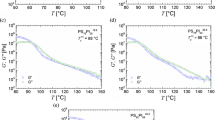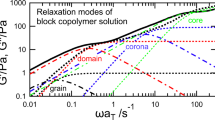Abstract
To determine the impact of molecular architecture on the molecular dynamics of the glass relaxation processes of soft blocks in different types of block copolymers, model block copolymers with a variation in both molecular architecture and chemical composition were studied. Four block copolymer models, namely, two styrene–butadiene–styrene (S-B-S) block copolymers and two styrene–styrene butadiene–styrene (S-SB-S) were chosen. In each pair of block copolymers, one is linear triblock and the other is star asymmetric. For the sake of comparison, two polybutadiene (PB) homopolymer samples, having similar chain lengths of the PB blocks present in the S-B-S block copolymers, have been investigated. Dynamic mechanical measurements have been carried out for the real and imaginary parts of the complex shear modulus (G′, G”) in the temperature and frequency ranges from −110 to 30 °C and from 10−2 to 15.9 Hz, respectively. Complete master curves have been constructed for all samples investigated. Moreover, broadband dielectric spectroscopy has been carried out to cover wide temperature and frequency windows, −120 to 0 °C and 10−1 to 107 Hz, respectively. The results showed that the molecular dynamics of the glass relaxation process of the PB or statistical PSB soft phases in the block copolymers is dramatically changed when compared to the PB homopolymer. In addition, the molecular architecture is found to be an important factor in determining the molecular mobility of the soft blocks. The results are discussed in terms of the applied confinement of the counter PS hard phase, block lengths, domain thicknesses and the type of end-to-end junctions between the different polymeric blocks.






Similar content being viewed by others
References
Adhikari R, Michler GH, Knoll K (2003) Morphology and micromechanical behaviour of styrene/butadiene block copolymers and their blends with polystyrene. Macromol Symp 198:117–134 (7th European Symposium on Polymer Blends, 2002)
Adhikari R, Buschnakowski M, Lebek W, Godehardt R, Michler GH, Calleja Balta FJ, Knoll K (2005) Asymmetric PS-block-(PS-co-PB)-block-PS block copolymers: morphology and deformation behavior of star block copolymer/PS blends. Polym Adv Technol 16:175–182
Alcoutlabi M, McKenna GB (2005) Effects of confinement on material behavior at the nanometer size scale. J Phys Condens Matter 17:461–524
Allen G, Bevington JC (1989) Comprehensive polymer science: the synthesis, characterization, reactions and applications of polymers, vol 2. Polymer properties. Pergamon, Oxford
Archibald DD, Mann S (1993) Template mineralization of self-assembled anisotropic lipid microstructures. Nature 364:430–433
Bates FS (1984) Block copolymers near the microphase separation transition. 2. Linear dynamic mechanical properties. Macromolecules 17:2607–2613
Bates FS, Fredrickson GH (1999) Block copolymers: designer soft materials. Phys Today 52:32–38
Dalnoki-Veress K, Forrest JA, de Gennes PG, Dutcher JR (2000) Glass transition reductions in thin freely-standing polymer films: a scaling analysis of chain confinement effects. J de Physique IV: Proceedings 10 Pr7/221–Pr7/226 (Pr7, International Workshop on Dynamics in Confinement, 2000)
Dalnoki-Veress K, Forrest JA, Murray C, Gigault C, Dutcher JR (2001) Molecular weight dependence of reductions in the glass transition temperature of thin, freely standing polymer films. Phys Rev E 63:031801
Eisele U (1990) Instruction to polymer physics. Springer, Berlin
Ferry JD (1980) Viscoelastic properties of polymers, 3rd edn. Wiley, New York
Floudas G, Meramveliotaki K, Hadjichristidis N (1999) Segmental and chain dynamics of polyisoprene in block copolymer/homopolymer blends. A dielectric spectroscopy study. Macromolecules 32:7496–7503
Ge S, Pu Y, Zhang W, Rafailovich M, Sokolov J, Buenviaje C, Buckmaster R, Overney RM (2000) Shear modulation force microscopy study of near surface glass transition temperatures. Phys Rev Lett 85:2340–2343
Geiger K, Knoll K, Langela M (2002) Microstructure and rheological properties of triblock copolymers under extrusion conditions. Rheol Acta 41:345–355
Hadjichristidis N, Pispas S, Floudas G (2003) Block copolymers synthetic strategies, physical properties, and applications. Wiley, New York
Hajduk A, Harper PE, Gruner SM, Honeker CC, Kim G, Thomas EL, Fetters LJ (1994) The gyroid: a new equilibrium morphology in weakly segregated diblock copolymers. Macromolecules 27:4063–4075
Hajduk A, Ho RM, Hillmyer MA, Bates FS, Almdal K (1998) Transition mechanisms for complex ordered phases in block copolymer melts. J Phys Chem B 102:1356–1363
Havriliak S, Negami S (1967) A complex plane representation of dielectric and mechanical relaxation processes in some polymers. Polymer 8:161–205
He F, Wang LM, Richert R (2005) Dynamics of supercooled liquids in the vicinity of soft and hard interfaces. Phys Rev B 71:144205.1–144205.10
Heinrich W, Stoll B (1988) Description of the freezing-in process in poly(vinyl acetate) based on the meander model. Prog Colloid Polym Sci 78:37–53
Hofmann A, Algeria A, Colmenero J, Willner L, Buscaglia E, Hadjichristidis N (1996) Secondary and segmental relaxation in polybutadienes of varying microstructure: dielectric relaxation results. Macromolecules 29:129–134
Horak Z, Fort V, Hlavata D, Lednicky F, Vecerka F (1996) Compatibilization of high-impact polystyrene/polypropylene blends. Polymer 37:65–73
Hueckstaedt H, Goldacker T, Goepfert A, Abetz V (2000) Core-shell double gyroid morphologies in ABC triblock copolymers with different chain topologies. Macromolecules 33:3757–3761
Huy TA, Adhikari R, Michler GH (2003) Deformation behavior of styrene–block–butadiene–block–styrene triblock copolymers having different morphologies. Polymer 44:1247–1257
Jackson CL, McKenna GB (1991) The glass transition of organic liquids confined to small pores. J Non Cryst Solids 131–133:221–224
Jain TS, de Pablo JJ (2002) Monte Carlo simulation of free-standing polymer films near the glass transition temperature. Macromolecules 35:2167–2176
Kahle S, Schroter K, Hempel E, Donth E (1999) Calorimetric indications of a cooperativity onset in the crossover region of dynamic glass transition for benzoin isobutyl ether. J Chem Phys 111:6462–6470
Knoll K, Niessner N (1996) Application of anionic polymerization research: developed from a symposium sponsored by division of polymer chemistry: the 212th National Meeting Of The American Chemical Society, Orlando, Florida (August 25–29)
Knoll K, Niessner N (1998) Styrolux and styroflex. From transparent high impact polystyrene to new thermoplastic elastomers. Syntheses, applications, and blends with other styrene-based polymers, (International Symposium on Ionic Polymerization, 1997). Macromol Symp 132:231–243
Kresge CT, Leonowicz ME, Roth WJ, Vartuli JC, Beck JS (1992) Ordered mesoporous molecular sieves synthesized by a liquid-crystal template mechanism. Nature 359:710–712
Liu G (1997) Nanofibers. Adv Mater 9:437–439
MacFarlane DR, Angell CA (1982) An emulsion technique for the study of marginal glass formation in molecular liquids. J Phys Chem 86:1927–1930
Mansour AA, Mohamed MA, Minko S (2003) Effect of block position on the dynamics of the glass processes in carbonate/styrene triblock copolymers. J Elastomers Plast 35:277–294
Mohammady SZ, Mansour AA, Von Soden W (2001) Effect of crosslinking on block and random copolymers of styrene and butadiene. Macromol Chem Phys 202:2732–2741
Mohammady SZ, Mansour AA, Knoll K, Stoll B (2002) Detection of the glass relaxation process of the PS-phase in block copolymers. Polymer 43:2467–2478
Morkved TL, Wiltzius P, Jeager HM, Grier DG, Witten TA (1994) Mesoscopic self-assembly of gold islands on diblock-copolymer films. Appl Phys Lett 64:422–424
Nakajima N (1996) Viscoelastic behavior of styrene–butadiene–styrene block copolymers in temperature range of glass–rubber transition of styrene block. Rubber Chem Technol 69:73–80
Pakula T, Floudas G (2000) Dynamics and viscoelastic effects in block copolymers: real and simulated systems, Marcel Dekker, New York
Pissis P, Daoukaki-Diamanti D, Apekis L, Christodoulides C (1994) The glass transition in confined liquids. J Phys Condens Matter 6(21), L325–L328
Richter N (1996) Ph.D. thesis, Ulm University, Ulm, Germany
Roland CM, Ngai KL (1991) Segmental relaxation and molecular structure in polybutadienes and polyisoprene. Macromolecules 24:5315–5319
Rosedale JH, Bates FS (1990) Rheology of ordered and disordered symmetric poly(ethylenepropy1ene)–poly(ethylethy1ene) diblock copolymers. Macromolecules 23:2329–2338
Roth CB, Dutcher JR (2004) Mobility on different length scales in thin polymer films. In: Dutcher JR, Marangoni AG (eds) Soft materials: structure and dynamics. Dekker, New York
Ryan AJ, Macosko CW, Bras W (1992) Order–disorder transition in a block copolyurethane. Macromolecules 25:6277
Sierra CA, Galan C, Fatou JG, Parellada MD, Barrio JA (1997) Thermal and mechanical properties of poly(styrene-b-ethylene-co-butylene-b-styrene) triblock copolymers. Polymer 38:4325–4335
Tse MF (1989) Studies of triblock copolymer-tackifying resin interactions by viscoelasticity and adhesive performance. J Adhes Sci Technol 3:551–570
Wang LM, He F, Richert R (2004) Slow dynamics and the glass transition in confining systems. Mater Res Soc Symp Proc 790:P8.6.1–P8.6.12
Wendt H, Richert R (1999) Cooperativity and heterogeneity of the dynamics in nano-confined liquids. J Phys Condens Matter 11:A199–A206
Weyer S, Hensel A, Korus J, Donth E, Schick C (1997) Broad band heat capacity spectroscopy in the glass-transition region of polystyrene. Thermochim Acta 304/305:251–255
Wohlgemuth M, Yufa N, Hoffman J, Thomas EL (2001) Triply periodic bicontinuous cubic microdomain morphologies by symmetries. Macromolecules 34:6083–6089
Wu L, Cochran EW, Lodge TP, Bates FS (2004) Consequences of block number on the order–disorder transition and viscoelastic properties of linear (AB)n multiblock copolymers. Macromolecules 37:3360–3368
Xu G, Lin S (1996) Diblock copolymer compatibilizers for blends of isotactic polystyrene and isotactic polypropylene. Polymer 37:421–427
Zhang J, Liu G, Jonas J (1992) Effects of confinement on the glass transition temperature of molecular liquids. J Phys Chem 96:3478–3480
Zorn R, Mckenna GB, Willner L, Richter D (1995) Rheological investigation of polybutadienes having different microstructures over a large temperature range. Macromolecules 28:8552–8562
Zorn R, Mopsik FI, Mckenna GB, Willner L, Richter D (1997) Dynamics of polybutadienes with different microstructures. 2. Dielectric response and comparisons with rheological behavior. J Chem Phys 107:3645–3655
Acknowledgement
The author gratefully acknowledge the Deutscher Akademischer Austauschdienst (DAAD) and Max Plank Institute for Polymer research (MPIP) for the financial support provided. Many thanks are due to Dr. S. Khale for assistance in programming, data fitting and DETA measurements. I would like to thank Prof. Dr. A. Burbidge and Dr. J. Ubbink for their valuable suggestions during the revision of this work.
Author information
Authors and Affiliations
Corresponding author
Rights and permissions
About this article
Cite this article
Mohammady, S.Z. Molecular dynamics of the glass relaxation process of the soft phase in block copolymers: effect of molecular architecture. Rheol Acta 46, 1109–1119 (2007). https://doi.org/10.1007/s00397-007-0204-9
Received:
Accepted:
Published:
Issue Date:
DOI: https://doi.org/10.1007/s00397-007-0204-9




